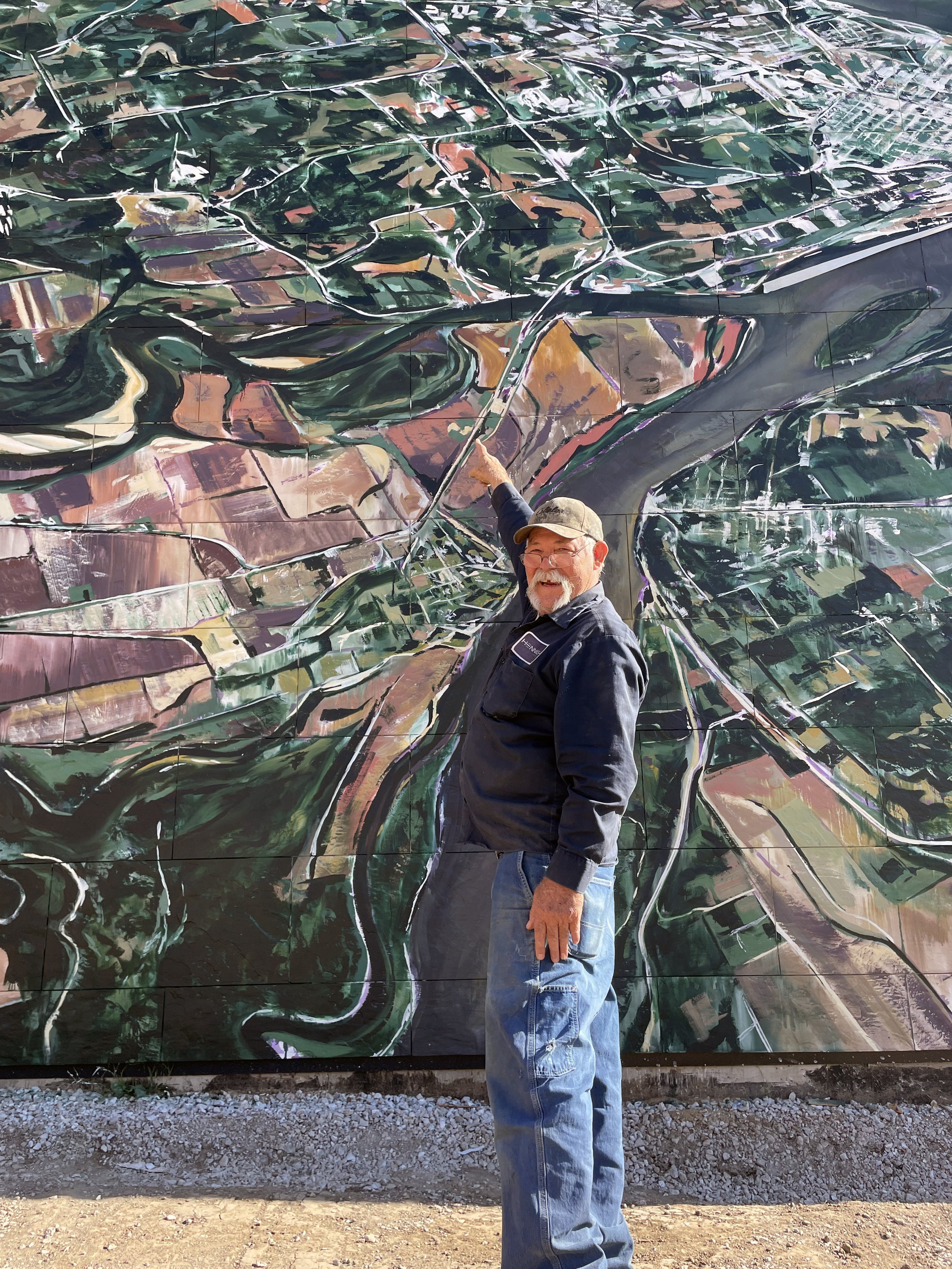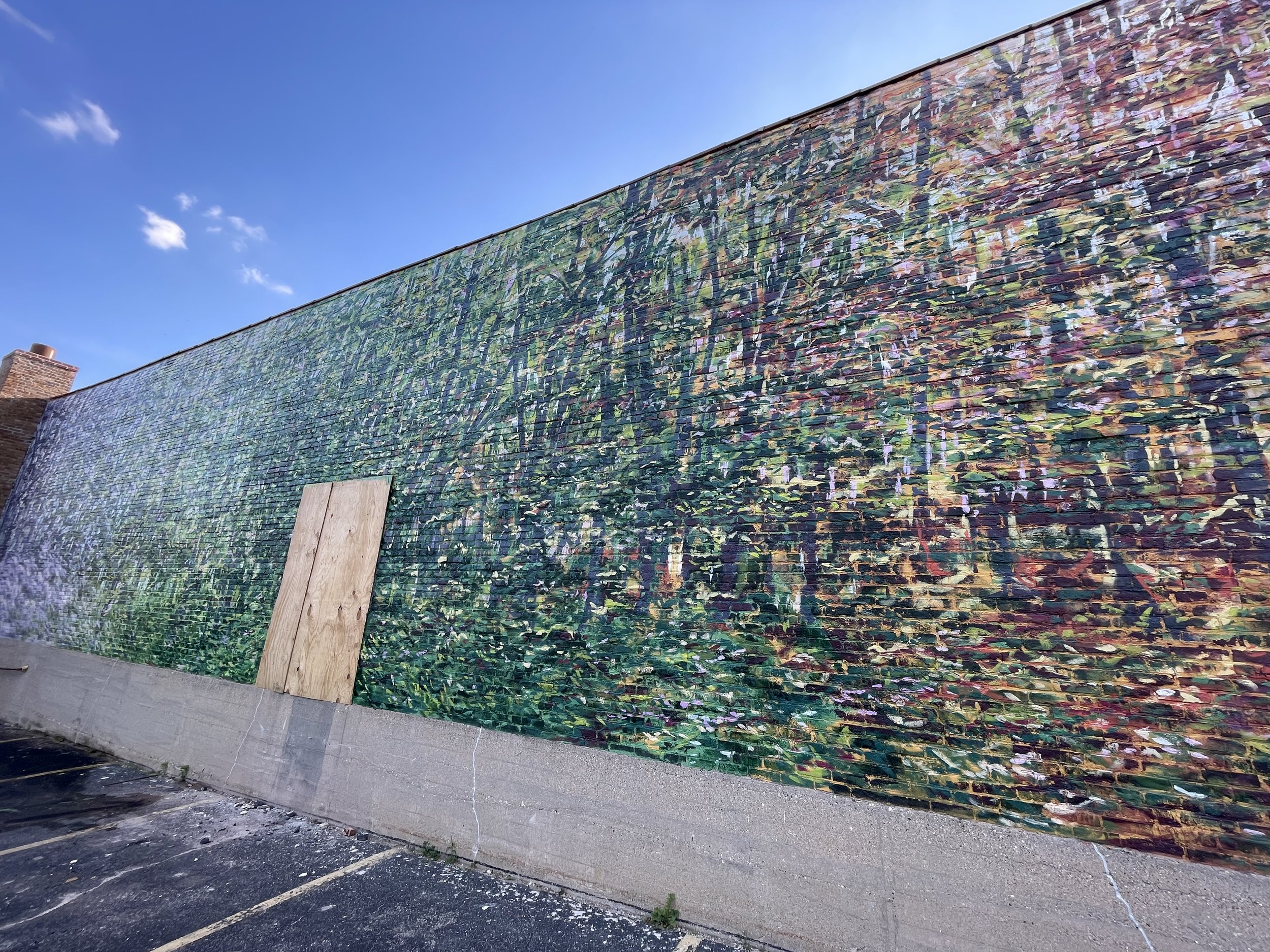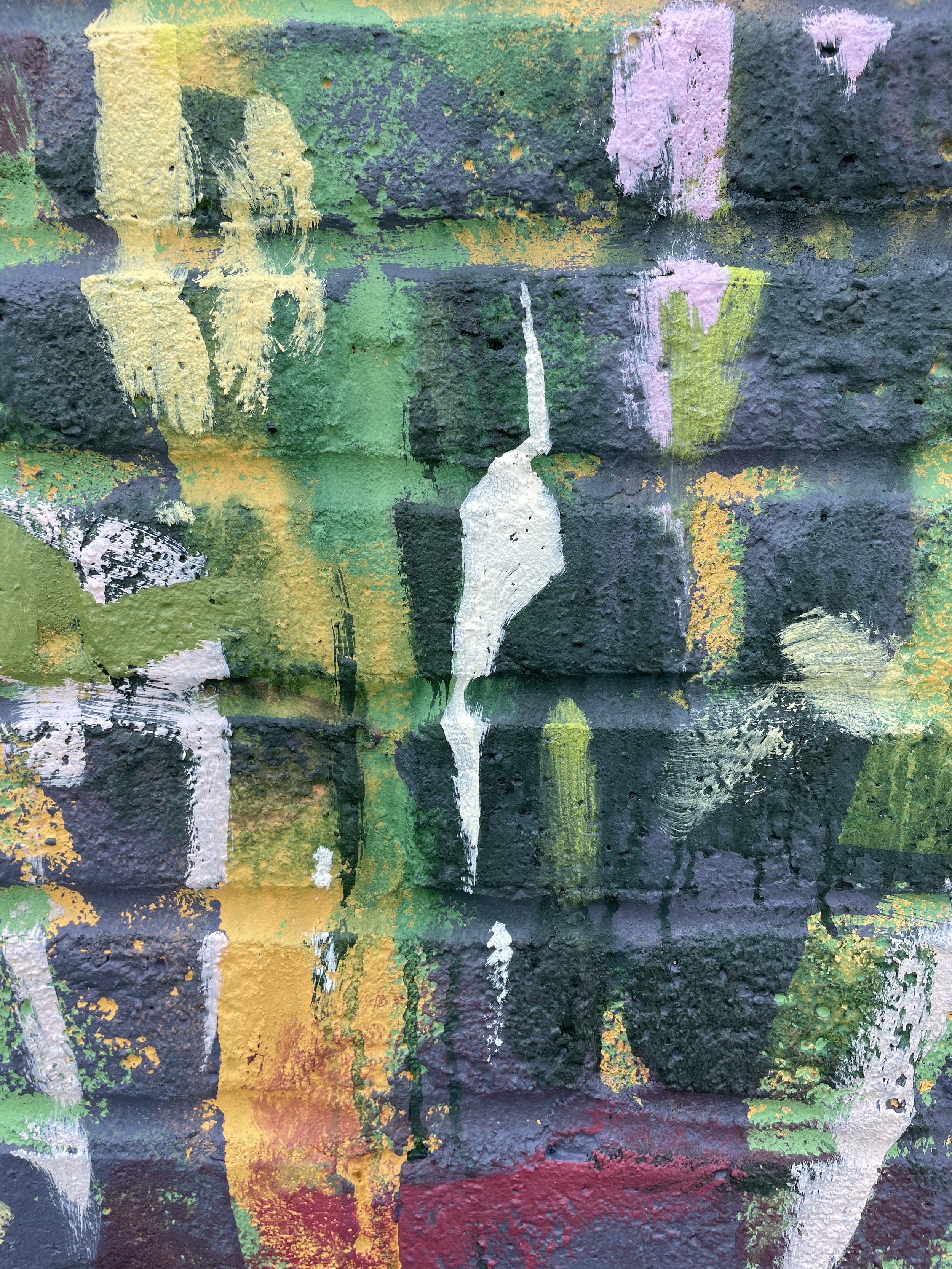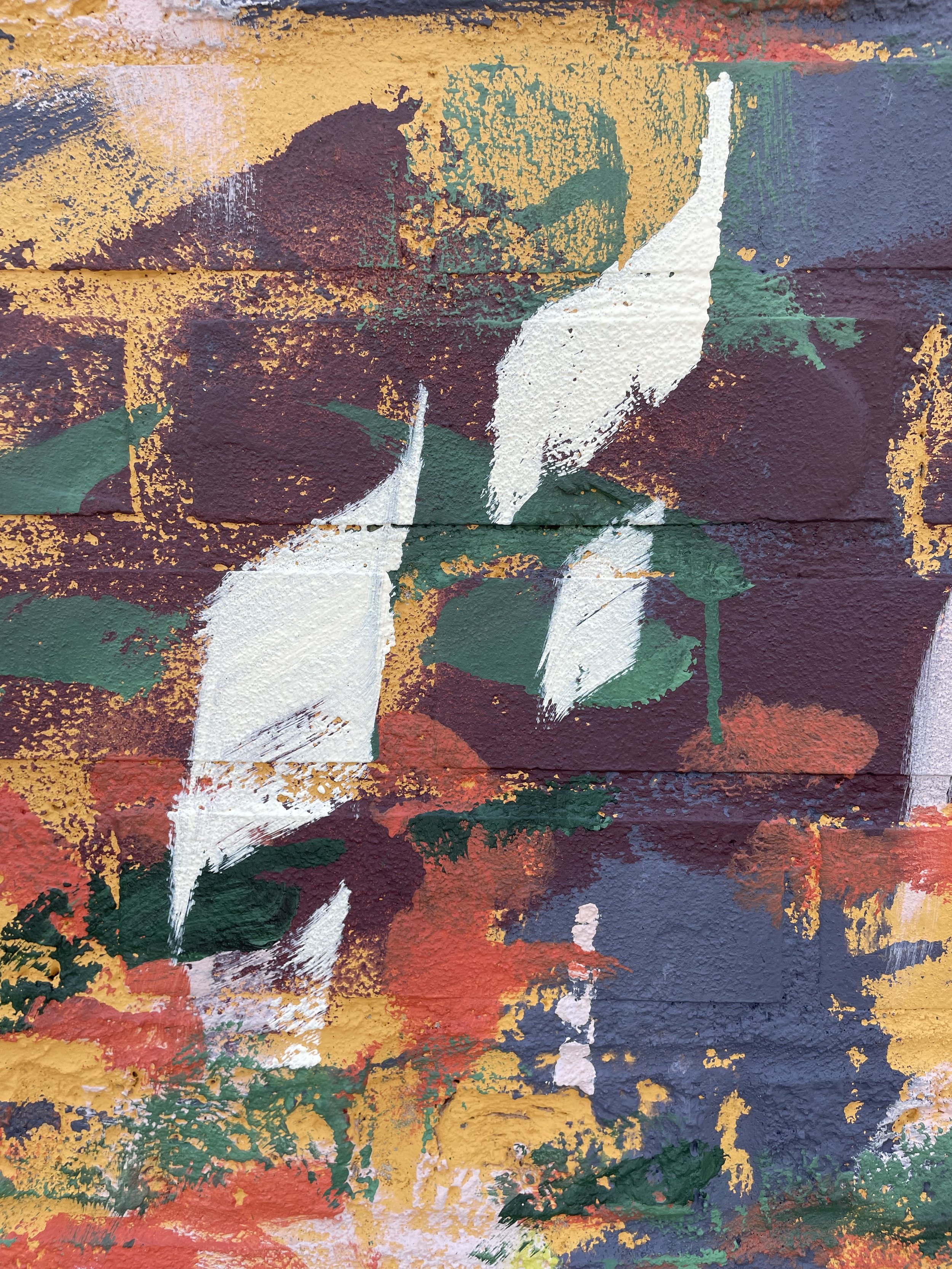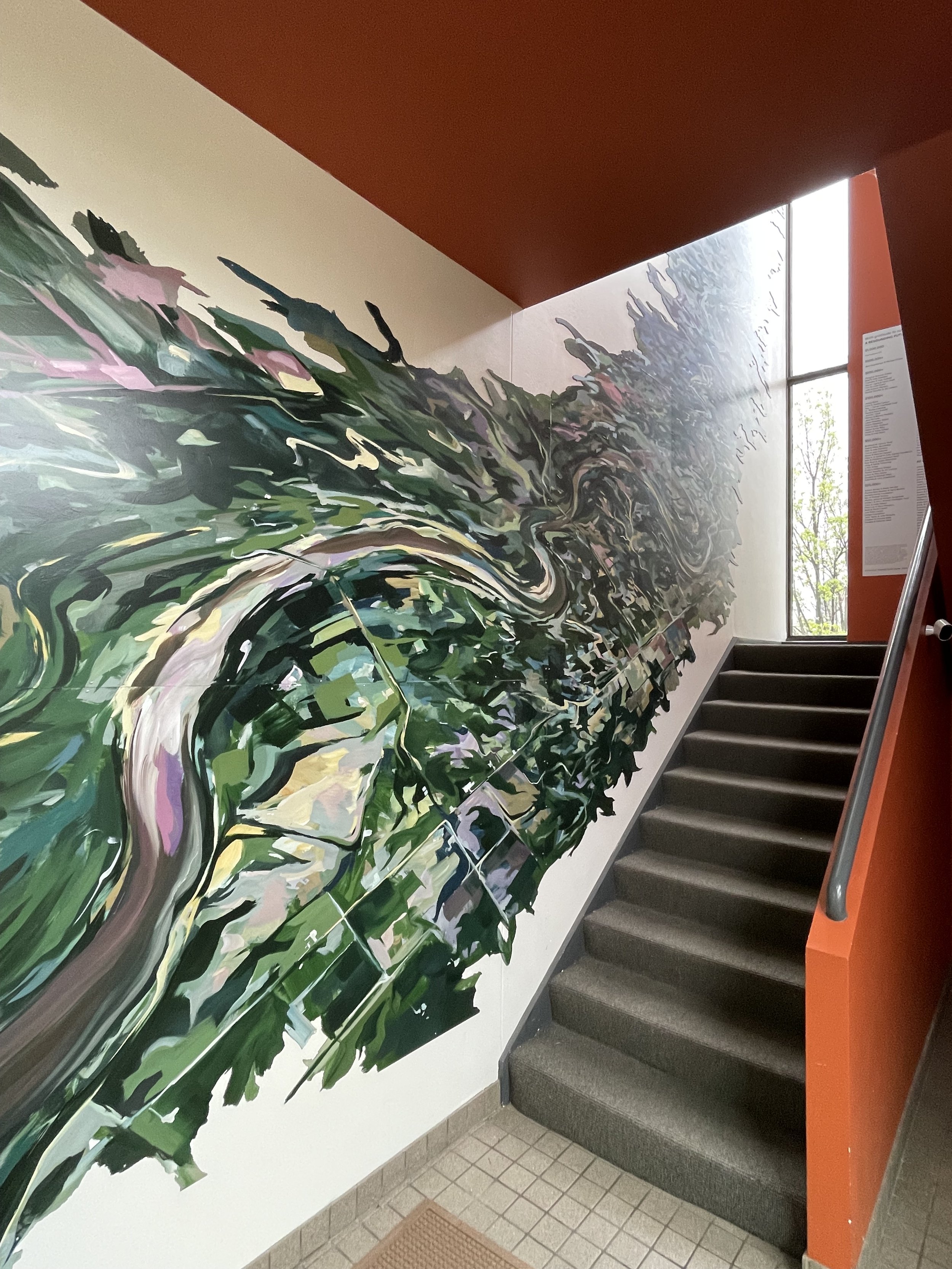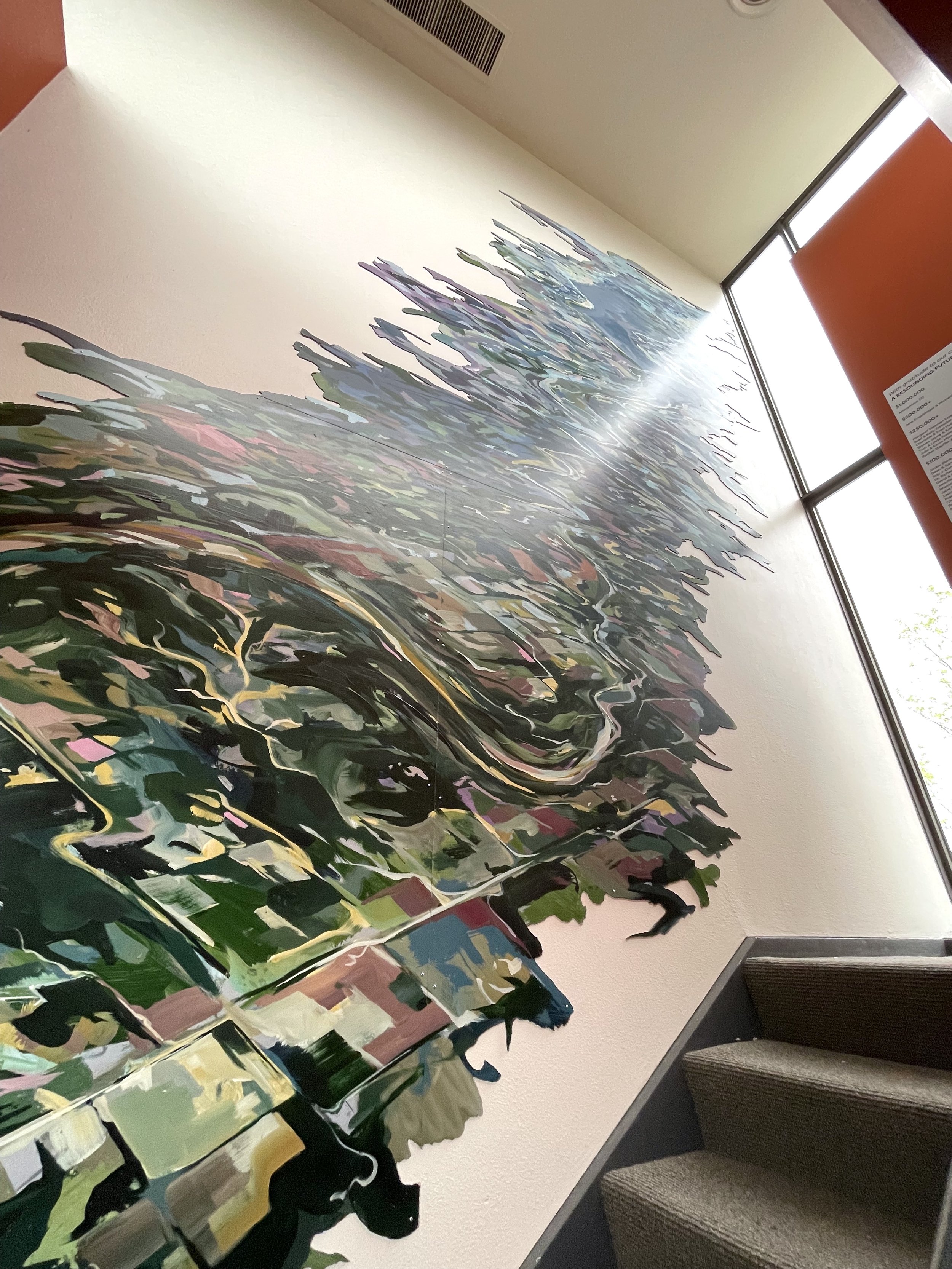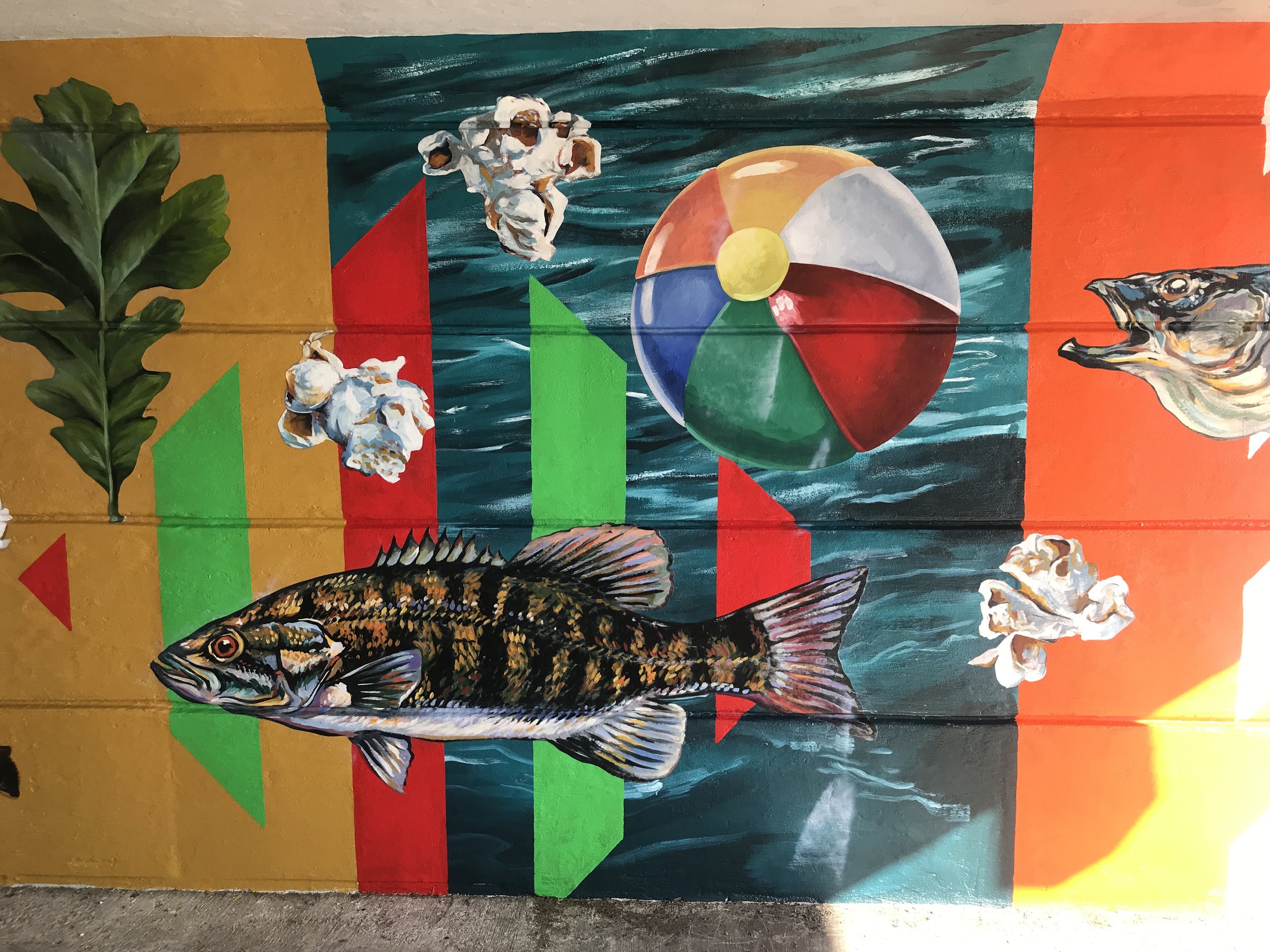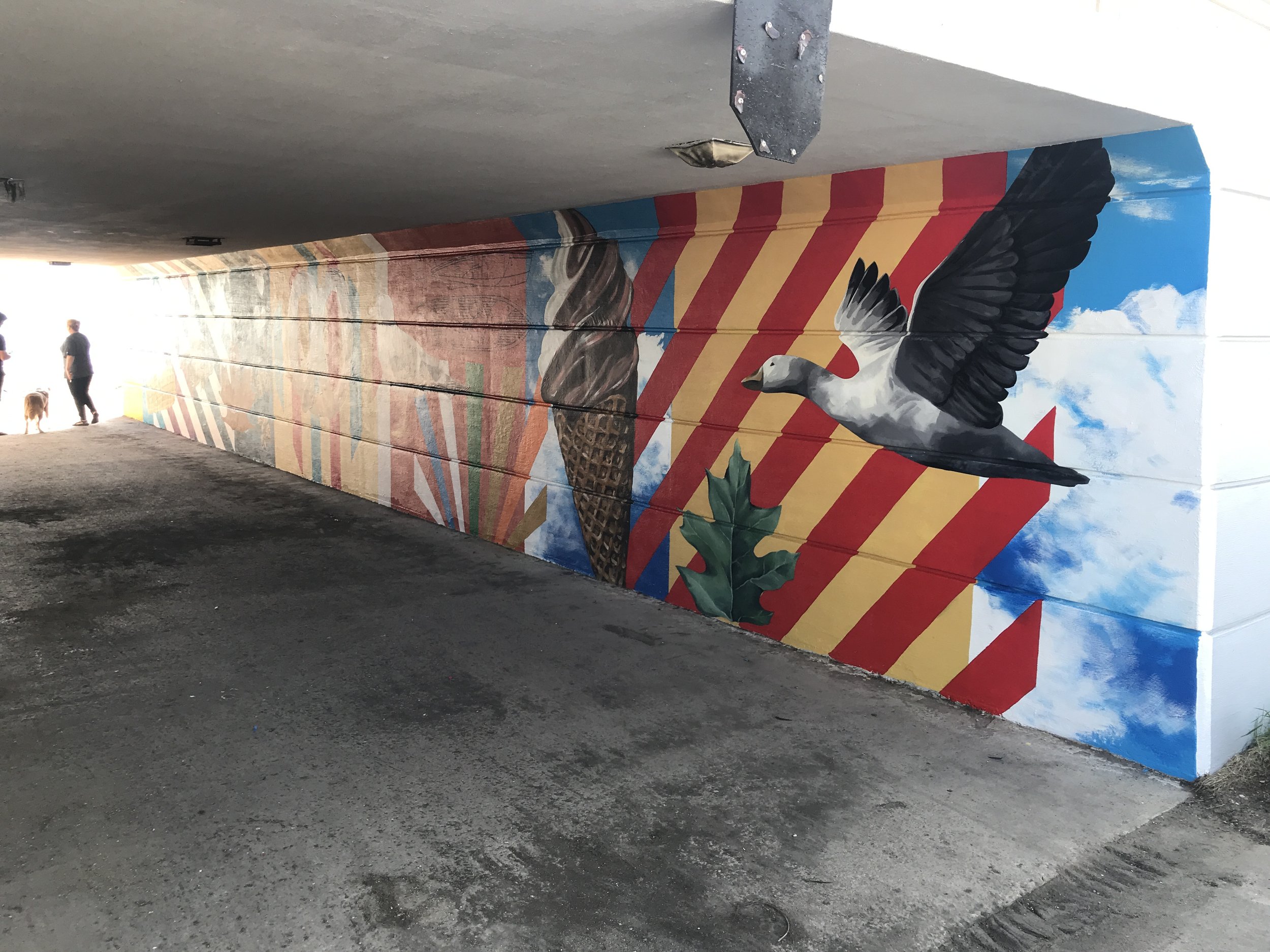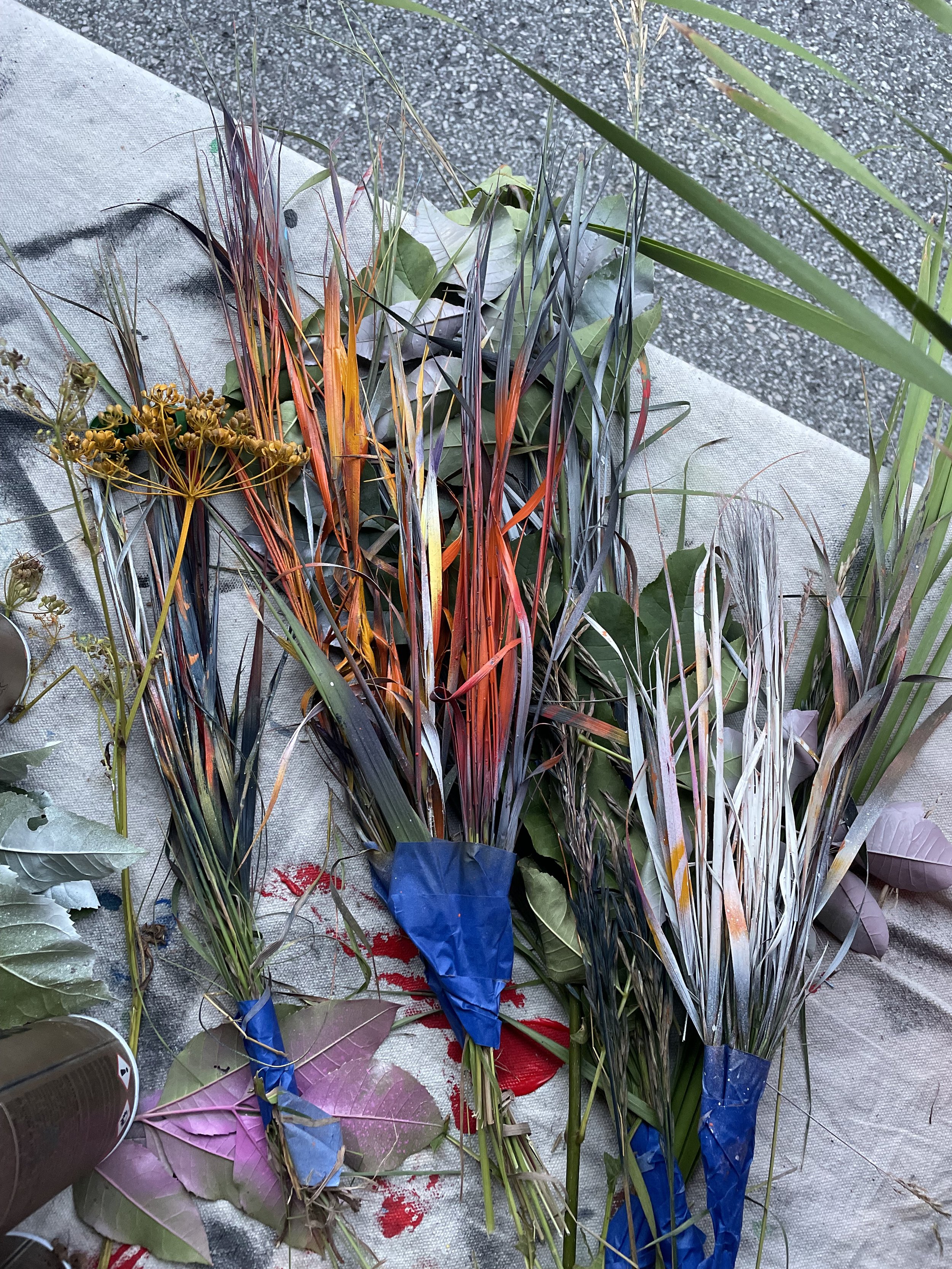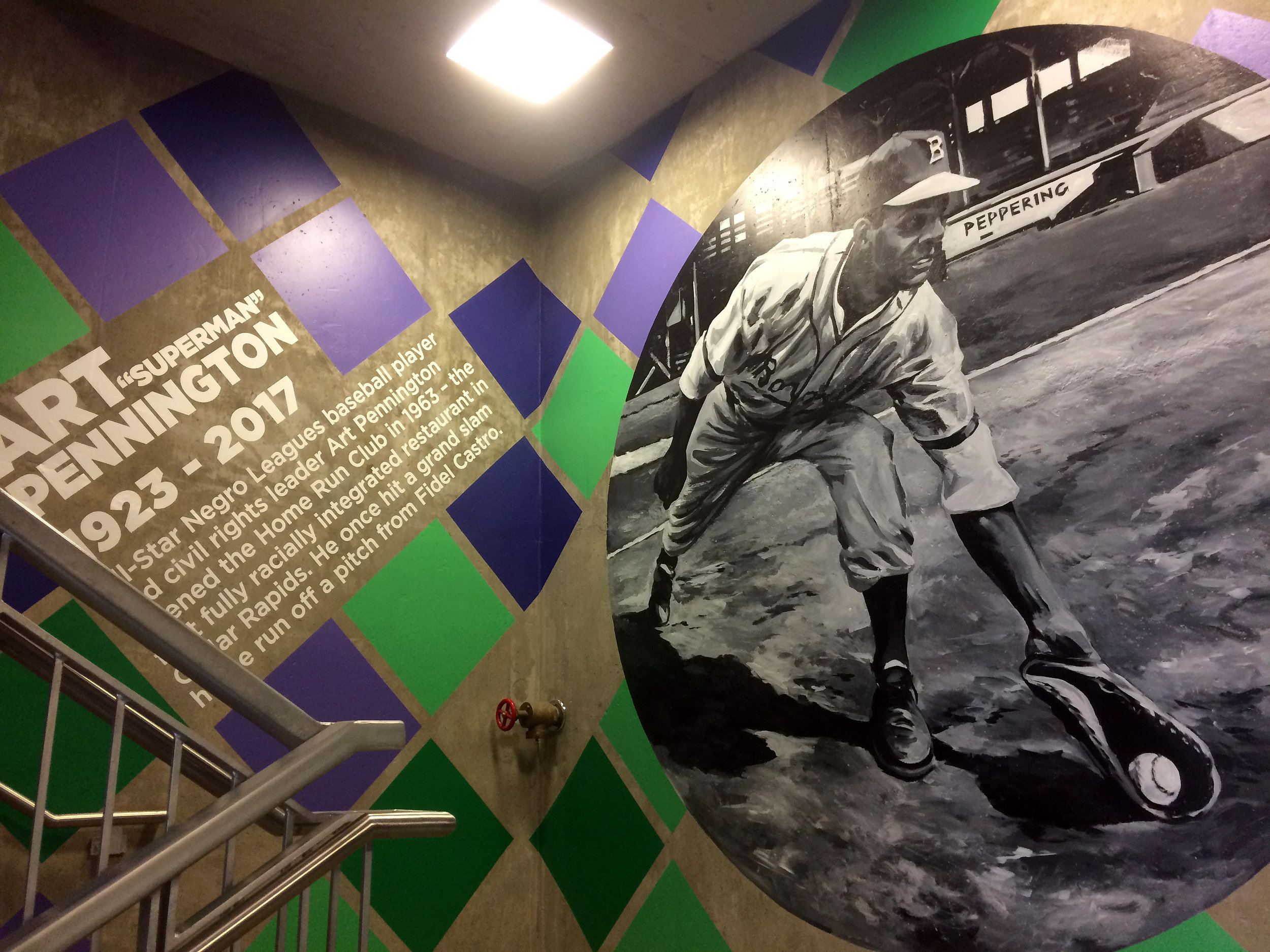Since 2013 I have painted over 50 large scale public murals for municipal, non-profit, private, and corporate commissions, and mentored and managed dozens more. Murals allow me to work in a variety of styles, from more graphic and abstract, to painterly and representational. They provide my artistic practice a gift of diversity and new challenges, opportunities to connect and collaborate with artists, communities, and business owners, the ability to directly brighten the walls of my own community, as well as fresh air and (mostly) sunny days.
My murals eschew the more garish, increasingly homogenous and repetitive mural tropes of “creative placemaking,” in favor of painterly language and the warmth of human touch as a central motif in public space.
The mural is a serpentine and atmospheric view of the confluence of the Des Moines and the Mississippi, the point at which this old river town resides. I worked with a team of community leaders to find a design they felt honored a sense of place in a unique way that didn’t feel like Keokuk was emulating other cities with the same repetitive murals of placemaking riffs.
The organic human touch and natural palette helps to not overwhelm this intersection, located at the very heart of town. “It’s a scene so familiar to us but a vantage point we never have.” Crystalline from afar, it disintegrates into a riot of marks up close, which is to say, it’s a painting not a sign. The area in front of the mural will be a new green space, part of the multi-building restoration happening on this block by Green Oak, a local developer who sees the value in reimagining these old 19th century buildings.
Unlike any community I’ve worked in, the outpouring of curiosity and enthusiasm for this project was striking. Like a lot of river towns, Keokuk’s population is less than two thirds what it once was, and you’d be lying if you said you didn’t feel it when you’re there. Many of the hundreds who thumbs upped and waved and stopped said, “things like this just don’t happen in Keokuk.” But Keokuk is also a town with its own local radio station, local paper, and a recently restored cathedral of a train station. And so, these things do happen in places like Keokuk, if you make them. That’s the narrative this group of community leaders and the donor behind the project wanted to set, and the endless stream of honking and thumbs up tells me they have really pulled it off.
This painterly mural features an atmospheric collage of cyanotypes of prairie plants made during an artist residency in the Flint Hills of Kansas – home to the largest intact remnant of tallgrass prairie. Cyanotypes, a Victorian photographic technique known for its brilliant Prussian blue color, were used by English botanist Anna Atkins to publish the first book illustrated by photography in 1843, the same time Iowa's prairies began to rapidly fall to Deere's moldboard plow. Brush painted and 175’ long, this mural is one half of a pair of murals located in downtown Iowa City, Iowa.
Photo: Christopher Hunter
Located in Roscoe, Illinois, outside of Rockford, northwest of Chicago, this mural was completed for the CRE8IV mural festival. The image features an aerial view of the Pecatonica River as it flows towards the Rock River – interactions of the midwestern grid, the agricultural landscape, with the wildness of the river, capture the landscape, character, and history of the area – agriculture and industry, sewn together by the watershed.
Painted in Rockford, Illinois, “Forest City", this loose, gestural mural activates a high visibility wall within a residential neighborhood. A natural motif with bold open handling, the mural ultimately integrates gently into the neighborhood, presenting a long read and an intentional absence of any overtly commercial or overbearing motif. Painted with Drew Etienne, the wall is approximately 18’x60’.
Completed for Trumpet Blossom Cafe in Iowa City, Iowa, this 16’x50’ mural was designed in collaboration with a local flower shop, Willow & Stock, to revitalize a patio after a municipal construction project decimated the nearby canopy. The mural was painted using a scaled reference and actual plant specimens to appear like they rest on the wall itself.
Painted for Iowa Public Radio to celebrate their successful capital campaign, this site specific installation wraps the entry stairwell at their Des Moines headquarters. Wall text: Watersheds present narrative truth, powerfully authoring the composition of our landscape in strict defiance of attempts to control it. These serpentine, calligraphic marks on the landscape are beautiful – gathering and snaking their way through our communities, tirelessly pushing back against the geometry so many seek to enforce. Every trickle gathers into our sloughs and creeks, our central waterways, and eventually runs through our Capitol as the Des Moines River, paralleling Public Radio’s model of tiered community support. As IPR transitions from publicly-funded to funded-by-the-public, our watershed provides lessons not just for sharing the stories of our communities, but how to sustain it.
Approximately 16’x60’, this mural features a design that celebrates the original historic use of the building as a farrier and tack shop, with a draught horse motif and design. The repeating, shifted design, emphasises the horizontal tension of the building coupled to the horizontal pull of the horse.
Inspired by Venezuelan artist Manuel Cabré, this 14’x16’ mural was painted on aluminum composite panels and installed on the top floor patio of a private client to remind them of their home. The mural has a seamless hidden door to allow access to HVAC equipment behind the mural.
This mural was funded by a small grant and done as a gift to the children, families, and staff at the Bloomington Street Headstart Preschool. Designed as informed by an engagement project with the children, the mural embodies a youthful spirit and energy, and is painted with subtle illusionism to look just like the cut paper collage that inspired it. The mural is approximately 16’x100’ and was designed in collaboration with artist Sayuri Sasaki Hemann.
This 8’x100’ mural was painted partially off-site using Polytab and finished and installed on site over the course of three days. The mural plays on both natural and whimsical/nostalgic themes in associations with Okoboji as a historic destination for retreat as well as its natural beauty. The imagery was developed from a site visit to Okoboji and its museums, as well as interviews with families that have multigenerational traditions of traveling to the area. Images below are a few details from the project which is in a tunnel accessing the only public beach in the area.
A pop up mural commissioned by Monster Energy, the design features a prairie burn taken from images from a neighbor’s land. Brush painted with aerosol stenciling of actual prairie plants, the substrate made up of skateboard decks was disassembled at the end of the event and given away for a zero-waste temporary project.
Wrapping the full interior of a six story stairwell of a high traffic parking deck in Cedar Rapids, this commission features diverse portraits of under celebrated and/or whimsical characters from Cedar Rapids’ history, including local civil rights leaders. Large scale, representational portraits at each landing combine with graphic wayfinding elements serving some of the practical needs of the structure as well as redefining the atmosphere.

